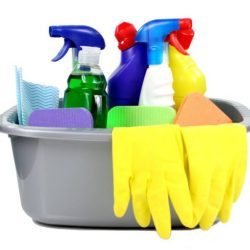Under the freezing winter months, there’s nothing like curling up in a blanket next to a warm fireplace, isn’t it? But, what happens when soot eventually condenses into creosote, a sticky, poisonous material found in your fireplace? You don’t want to know that.
If you want to keep your detailed stonework or impeccable marble fireplace clean, I suggest making an effort to clean your fireplace.
Cleaning Tips

For A Quick Fix, Use A Store-bought Cleaner
You may clean your fireplace using regular home cleaners. There are other cleansers designed exclusively for fireplaces that you may purchase.
Ammonia can be a good cleanser, but it can be hard on brick fireplaces. A fireplace may also be cleaned with oven cleaning. It can be effective if your fireplace has a lot of built-up charred stuff.
You can look for fireplace cleaners at your local hardware shop. These could be gentler on your fireplace. Fireplace cleansers, such as Quick n’ Brite, may need to be diluted before use, so make sure you read all the instructions carefully.
Make Your Own Cleaner For A More Natural Solution
If you’re allergic to chemicals, you can make your own cleaning. Typically, you may prepare a cleaner with ingredients from your kitchen.
- To prepare a high-quality DIY cleaner, mix 2 teaspoons (30 mL) of cream of tartar with water.
- You may also make a cleanser by combining equal parts vinegar and water. To apply the cleaning, pour it into a spray bottle.
- Combine 2–3 tbsp (30–44 mL) dish soap + 12 cup (260 g) baking soda. Make a paste out of this for a high-quality DIY cleaning.
Make Sure You Have A Multi-purpose Cleaning Spray On Hand
You clean the fireplace using an all-purpose cleaner before using any other cleaning. Something like 409 spray, which is widely available at stores, might work nicely here.
If you’re using a store-bought cleaner, check sure it doesn’t react poorly with your all-purpose spray.
Sweep The Hearth With A Little Brush
Grab a small brush and sweep the fireplace quickly before cleaning. Small brooms may be found at most department stores.
Examine the pet section. Small brooms and dustpans are frequently sold on picking up cat litter. This method might be used to clean a fireplace.
Obtain An Abrasive Tool
This is for removing rubbish from your fireplace. For cleaning a fireplace, use a scrub brush or an abrasive sponge.
Such items are available in most supermarkets and department stores.
What To Do To Remove Soot?

Step 1:
Safeguard the surrounding region. Protect yourself from filth and debris by wearing an apron or old clothing. Cover the floor around the fireplace with a tarp. Cleaning the fireplace is a filthy job, and soot may be difficult to remove from clothing or carpeting.
If you don’t have a tarp, you may make one out of old clothing or towels. Make sure it’s not anything you’re emotionally tied to, as it will most certainly be damaged throughout the cleaning procedure.
Step 2:
Prior to cleaning, all old wood and other debris should be removed. Put on some cleaning gloves and start clearing away the clutter.
Make a note of any salvageable wood and save it for later. To take up particularly loose material, you may also need to use a vacuum.
Step 3:
Sweep the floor with a tiny brush. Sweep any dust or ashes from the interior of the chimney thoroughly.
It may be beneficial to sprinkle coffee grinds over the ashes first. This can give them a more solid feel and prevent ashes from dispersing in the air.
Remember to sweep the ash off the opening to the chimney as well, since it is likely to be covered in ash.
Step 4:
Clean the fireplace using an abrasive implement soaked in cleaner. Scrub with your abrasive implement after dipping it in the cleanser. If the stains on the chimney are small, 10 to 15 minutes should be enough. Wait at least 30 minutes if the stains are severe.
Step 5:
The cleaner should be used to remove dirt and debris from the fireplace. With little washing and cleaning, you should be able to remove them quickly.





